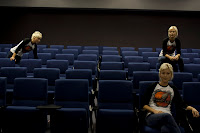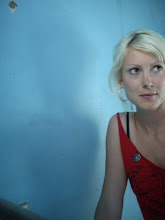Tuesday, June 1, 2010
Introduction to Digital Photography
Final Folio Reflecting and Presenting
- Travel/places.......Escapism
- People/anthropology/pogonology........Beardisms
Sunday, May 30, 2010
Portraiture photography - Richard Avedon




Thursday, May 27, 2010
Exactitudes




Wednesday, May 26, 2010
Pogonology exploration on Brunswick street
All of my subjects i had stand 2 metres from the wall excpet for two subjects. One older subject was seated at a cafe with people behind him, this became quite distracting to the eye. To bring more attention to the subject i used Photoshop to desaturate the colour from the background.
Using the polygonal lasso tool to select the area and a new adjustment layer for Hue/saturation at about -60 saturation and add slight colour to the subject.
Friday, May 21, 2010
Some Randoms
Thursday, May 20, 2010
Final Folio - Working with depth of field
- The smaller the aperture, the deeper the depth of field (the other two factors remaining the same). For example, if the lens focal length and the shooting distance stay the same, the depth of field is much deeper at f/16 than at f/1.4.
- The shorter the lens focal length, the deeper the depth of field (the other two factors remaining the same). For example, comparing a 28mm lens with a 50mm lens at the same aperture and shooting distance, depth of field is deeper with the 28mm lens.
- The greater the shooting distance, the deeper the depth of field. i.e. other two factors remaining the same). For example, if the subject is photographed from three and then from seven meters away, the zone of sharpness in the foreground and background is greater at seven meters.
Another characteristic of depth of field is that it is generally deeper in the background than in the foreground.
After working with portraiture photography, i have been trying to determine my constants. Whether it be the light, background, distance, angle or subjects, i needed a constant to connect my work. I wanted the backgrounds to be included in my work to support/compliment the character and the surroundings that they are in. For example the photograph below was taken in the band room at my work, the Arthouse. This was before a gig and i wanted to portray the subject in his natural environment, which compliments his music identity. I had to use a flash for this photo, which i dont usually like to do as it flattens the face. For the other portraiture i have had the subject stand 2 metres from the wall and zoomed right in. I had to move to the correct position to get the portrait. The photo below is not in the position i had wanted, as his head is being chopped off, but i loved his body language.
Monday, May 17, 2010
Wk 9 - Final Folio


Wednesday, April 21, 2010
Wk 7 Annie Leibovitz

Sunday, April 11, 2010
Wk 6 using Photoshop
Sunday, March 28, 2010
Week 5 Image Quality and Photoshop

Montage attempt using Photoshop during week 5 class
- Do not touch the lens, this can make the light refract with the image is taken and warp the image.
- Stay away from moisture, wet days, the beach, windy days. If wanting to take a picture in these conditions, wait for the right moment and quickly store.
- Use silica to absorb moisture.
- Use of tripods is important. Gorilla tripods is an option
- If you cannot use a tripod, use settings 1/60 } 18-55 where the shutter speed is high (2.8, 3.5, 4.5) otherwise the camera will shake and get out of focus. The shutter when it flips up may also cause camera shake.
- Print size and sensory size is important. For 5-8MP use A4 - A3 size print. 8MP and up use A3-A2 size print.










































